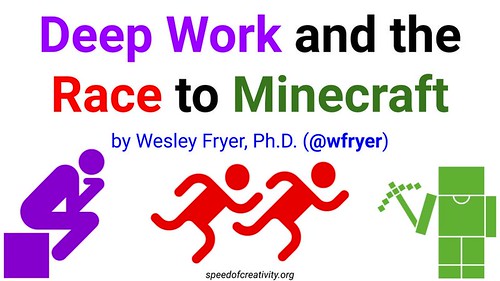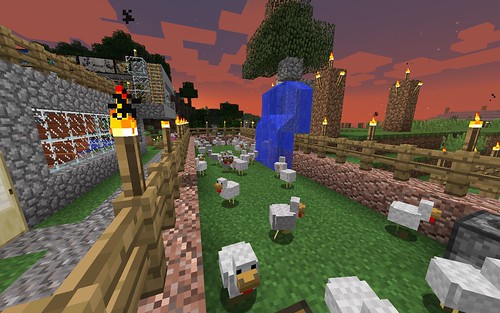Last Thursday was the last day of our second trimester at school, and therefore the end of my second opportunity in 2019-20 to teach Digital and Media Literacy to 5th and 6th Graders. As classroom teachers, one of the things we quickly learn is how different the dynamics of separate classes can be based on the composition of students, their personalities, and the ways in which students interact and sometimes “play off of” each other. In this post, I’d like to juxtapose Cal Newport’s concept of “Deep Work” as it applies to student learning and lessons, with Minecraft and the frequent passion with which young students regard opportunities to build, destroy, design, and interact in virtual worlds.
Our school requires 5th and 6th graders in our Middle Division / Middle School to take one trimester of “Computer Class.” This amounts to about 25 meetings every other school day of each trimester for 50 minutes. I’ve built the ten (or so) projects of our computer class curriculum this year on four different themes:
- Digital Literacy (working with Google Apps, learning to create and share different forms of multimedia)
- Media Literacy (understanding advertising as the basis for “brain hacking” and propaganda, focusing on critical thinking and validating web content)
- Digital Citizenship (practicing the ways we can respectfully and responsibly share our ideas online and interact with others digitally)
- Keyboarding (primarily through lessons and timed tests on Typing.com)
I’ve enjoyed using a “Minecraft Screencasting” project with each of my classes this year to introduce students to a variety of digital literacy skills. These include:
- Screencasting (with Screencastify)
- Saving a local file in a specific location with a customized filename (an exported Minecraft Education world, named with the current date)
- Uploading a file to a created folder in the cloud / on Google Drive
- Practicing oral / verbal fluency in a recorded screencast
- Sharing a video (either as a shared link or downloaded file) to our classroom learning journal, Seesaw
After that initial Minecraft Education lesson, I haven’t utilized Minecraft again in my curriculum, however. I’ve thoughtfully crafted guidelines for students’ “Free Choice Time” in our computer lab, which gives them different options for activities when their assignments for my class are complete. Building, designing and collaborating in Minecraft is one of those options, with the caveats that they cannot engage in PVP (player versus player attacks) or use TNT. Those are limitations at least some students question and “chafe at” a bit, but they are reasonable and generally my students who are “Minecraft fans” (and we have a LOT of those in 5th and 6th grade) are quite happy to have opportunities for “free choice” building in Minecraft with those limits.
Here’s where my thoughts about “Deep Work” and “a race to Minecraft” apply. Primarily in one of my fifth grade classes this last trimester, I had a group of boys who absolutely loved Minecraft and craved every opportunity they had to play and build in it. This led to a situation at the end of term when several of the students were racing through their assignments as quickly as they could, doing the minimum amount of work required, so they could have “free choice time” and play Minecraft. This was “the race to Minecraft.”
I’ve been listening to Cal Newport’s book, “Deep Work: Rules for Focused Success in a Distracted World,” on Audible intermittently the past few months, but have not finished it yet.
On his website explaining “Deep Work,” Newport writes:
Deep work is the ability to focus without distraction on a cognitively demanding task. It’s a skill that allows you to quickly master complicated information and produce better results in less time. Deep work will make you better at what you do and provide the sense of true fulfillment that comes from craftsmanship. In short, deep work is like a super power in our increasingly competitive twenty-first century economy. And yet, most people have lost the ability to go deep—spending their days instead in a frantic blur of e-mail and social media, not even realizing there’s a better way.
Deep Work: Rules for Focused Success in a Distracted World – Cal Newport. https://www.calnewport.com/books/deep-work/. Accessed 17 Feb. 2020.
The fifth graders in my computer class this past trimester attempting to engage in an almost continual “race to Minecraft” did NOT engage in “deep work” as Newport is defining it, on the digital literacy and media literacy lessons I had assigned and was assessing for the term. I do not doubt that these students were learning as they energetically engaged in various collaborative tasks and activities in Minecraft together… and I also think that these abilities to work effectively in virtual spaces / virtual worlds are important skills for our interconnected, digital age. As a classroom teacher, however, I found this situation frustrating as well as challenging, and ultimately worthy of reflecting on via this blog post.
Of course I could have changed our class “free choice” guidelines to prohibit Minecraft altogether, if I really wanted to “shut down” the dynamics of this “race to Minecraft.” I also could create more detailed rubrics and checklists for quality projects, which MIGHT slow down my students a little and get them to attend a little more to the quality and content of their work. Our last project of the trimester was creating a 5 to 10 image narrated slideshow video / digital story using Adobe Spark Video. I could have required that my students do a far less motivational activity when they finished their project work, like more lessons on Typing.com, since they would have possibly been less incentivized to “speed through” their assignments. “Shutting down students” in their enthusiasm to do something like build, collaborate and play in Minecraft is not what I really wanted to do here, however… so that is why I’m struggling with this situation.
Sometimes it’s helpful to consider a purely analog parallel to a digital situation to better understand it and consider how to handle it. In this case, I basically am providing students with the chance to have a slightly limited form of “outside recess” when they finish their project work and assignments in my class, when I’m letting them “play Minecraft” as a free-choice activity.
Not all of my students choose Minecraft during free-choice time. Especially after introducing students to some basics of creating animations in Scratch, some of them choose to continue building and creating in Scratch. I think that’s fantastic, and something I want to encourage. Our free choice guidelines include both “Coding your own projects in Scratch” and “Playing games YOU HAVE MADE in Scratch.” One of the biggest challenges we have in school today in most settings is a LACK OF TIME FOR UNSTRUCTURED PLAY. I actually mentioned this last night in our Sunday night #OklaEd Twitter chat. I believe unstructured play is important for people of all ages, in both physical/analog spaces as well as digital spaces. This likely explains some of my reluctance to “shut down” my students when they are so enthusiastic to build, work and play together in Minecraft after finishing their assignments.
I think this last trimester of the year, I may actually talk directly with my students about the concepts of “deep work” and discuss both my desire and the importance of them putting forth their best efforts to create quality projects in our class. I may connect this to our existing lesson and project on “Distraction Free Web Reading” using Pocket. Helping students develop their own capacity for self-regulation in a world increasingly filled with digital distractions is a HUGELY important life skill. I’ve enjoyed using initial “class meetings” at the start of each of our classes to usually watch and discuss a “Wonder Link” (frequently a video) and connect with each other. We’ve also used the AppleTV app and website Newsy.com to discuss current events as well as visual / digital storytelling techniques. A conversation about “deep work” during one or more of our meetings could yield some good conversational fruit and ideas about how to address these dynamics.
What are your thoughts? Please reach out by sharing a reply to me @wfryer on Twitter, by commenting on this Facebook post, or leaving an ‘old school’ comment below.


